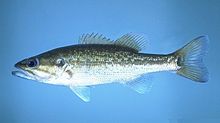Bass is a generic common name shared by many species of ray-finned fish from the large clade Percomorpha, mainly belonging to the orders Perciformes and Moroniformes, encompassing both freshwater and marine species. The word bass comes from Middle English bars, meaning "perch", despite that none of the commonly referred bass species belong to the perch family Percidae.
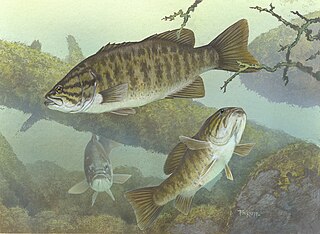
Micropterus is a genus of North American freshwater fish collectively known as the black bass, belonging to the sunfish family Centrarchidae of order Perciformes. They are sometimes erroneously called "black trout", but the name trout more correctly refers to certain members of the salmonid family.

The smallmouth bass is a species of freshwater fish in the sunfish family (Centrarchidae) of the order Perciformes. It is the type species of its genus Micropterus, and is a popular game fish sought by anglers throughout the temperate zones of North America, and has been spread by stocking—as well as illegal introductions—to many cool-water tributaries and lakes in Canada and more so introduced in the United States. The maximum recorded size is approximately 27 inches (69 cm) and 12 pounds (5.4 kg).

The largemouth bass is a carnivorous freshwater ray-finned fish in the Centrarchidae (sunfish) family, native to the eastern and central United States, southeastern Canada and northern Mexico. It is known by a variety of regional names, such as the widemouth bass, bigmouth bass, black bass, bucketmouth, largie, Potter's fish, Florida bass, Florida largemouth, green bass, bucketmouth bass, green trout, Gilsdorf bass, Oswego bass, LMB, and southern largemouth and northern largemouth.

The redeye bass, redeye, or Coosa bass is a species of freshwater fish in the sunfish family (Centrarchidae) native to the Coosa River system of Georgia, Alabama. The waters it is normally found in are cool streams and rivers in the foothills of mountains.

Bass fishing is the recreational fishing activity, typically via rod-based angling, for various game fishes of North America known collectively as black bass. There are numerous black bass species targeted in North America, including largemouth bass, smallmouth bass, spotted bass or Kentucky bass, and Guadalupe bass. All black bass species are members of the sunfish family Centrarchidae.

The shoal bass is a species of freshwater fish in the sunfish family (Centrarchidae) of order Perciformes. One of the black basses, it is native to waters in Florida and Georgia. It is also occasionally found in rivers and streams of East Alabama where it has been declared an endangered species and cannot legally be kept if caught by fishermen. Of typical size for a black bass, M. cataractae reaches a maximum recorded length of 24 inches (61 cm) and a maximum published weight of 8 pounds, 12 ounces.

The Guadalupe bass is a rare species of fish endemic to the U.S. state of Texas, where it also is the official state fish. It is restricted to creeks and rivers, and is listed as near threatened. Today, most fly fishermen and anglers practice catch-and-release techniques to improve fish populations. The Guadalupe bass is often difficult to distinguish from the smallmouth bass or spotted bass, and the fish is known to hybridize.

The rock bass, also known as the rock perch, goggle-eye, red eye, and black perch, is a freshwater fish native to east-central North America. This red-eyed fish is a species of freshwater fish in the sunfish family (Centrarchidae) of order Perciformes and can be distinguished from other similar species by the six spines in the anal fin.

The longear sunfish is a freshwater fish in the sunfish family, Centrarchidae, of order Perciformes. It is native to the area of eastern North America stretching from the Great Lakes down to northeastern Mexico. The longear sunfish reaches a maximum recorded length of about 24 cm (9.4 in), with a maximum recorded weight of 790 g (1.74 lb). Most do not live beyond six years. The longear sunfish is quite colorful, with an olive to rusty-brown back, bright orange belly and vermiculate blue-green bars on the sides of its head, the latter two features most pronounced in breeding males. A unique characteristic of longear sunfish is their elongated operculum flap, giving an appearance of a "long ear". It is black and often has a white margin. The pectoral fin is relatively short and would not reach the snout if it were reflected anteriorly. In breeding males, iridescent blue spots develop on the dorsum and sides and the fin membranes turn orange in all fins except the ventral ones, which may be blue to black, and the pectoral ones. Lepomis megalotis can be distinguished from closely related dollar sunfish L. marginatus by a greater number of cheek scale rows, by having one to two additional pectoral fin rays and by the slope of the opercular flap, which is distinctly upward in L. marginatus but is closer to horizontal in males of L. megalotis, although female and subadult L. megalotis may have upward slanting opercular flaps.

Alabama has a rich history and diversity of freshwater and saltwater sport fishing opportunities within its extensive rivers systems, farm ponds and the inshore and offshore saltwater of the Gulf of Mexico., The Bass Angler's Sportsman Society (B.A.S.S.), the leading promoter of competitive bass fishing was founded by Ray Scott in 1967 in Montgomery, Alabama. Alabama hosts numerous local, regional and national fishing tournaments every year.
Alabama supports 11 million angler fishing days with expenditures of three-quarters of a billion dollars, so join in the fun!
Austroglanis barnardi is an endangered species of catfish. It is one of three members of the family Austroglanididae. It is also known as the spotted rock-catfish or Barnard's rock-catfish.

The threadfin shad is a small pelagic freshwater forage fish common in lakes, large streams and reservoirs of the Southeastern United States. Like the American gizzard shad, the threadfin shad has an elongated dorsal fin, but unlike the gizzard shad, its mouth is more terminal without a projecting upper jaw. The fins of threadfin shad often have a yellowish color, especially the caudal fin. The back is grey to blue with a dark spot on the shoulder. D. petenense is more often found in moving water, and is rarely found deep in the water column. It occurs in large schools, sometimes with gizzard shad, and can be seen on the surface at dawn and dusk. The threadfin shad may reach lengths of 8 in (200 mm), but only rarely. This fish is very sensitive to changes in temperature and dissolved oxygen, and die-offs are frequent in late summer and fall, especially when water temperature drops to 42 °F. The threadfin shad is a favorite food for many game fishes, including striped bass, largemouth bass, smallmouth bass, and catfish. This fish is widely introduced throughout the United States as a forage for game fish.
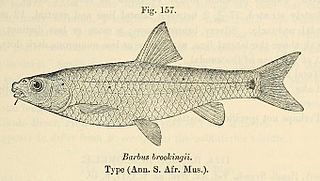
The border barb is a ray-finned fish species in the family Cyprinidae. It is the only species in the genus Amatolacypris. Like Pseudobarbus, it is tetraploid.

The blacktail shiner is a small freshwater fish in the family Cyprinidae native to the United States.

The warpaint shiner is a species of freshwater fish found in North America. It is common in the upper Tennessee River basin as well as in the Savannah River, the Santee River, and the New River in North Carolina. Adults have a mean length of 9 centimetres (3.5 in) and can reach a maximum length of 14 centimetres (5.5 in). The maximum age reported for this species is 4 years.

Micropterus henshalli, the Alabama bass, is a medium-sized freshwater ray finned fish, a black bass from the genus Micropterus which is part of the sunfish family Centrarchidae. This species is endemic to the southeastern United States where it is native to the rivers which drain into Mobile Bay in Florida, Alabama, Mississippi and Georgia where they are found in pools in rivers which have a good flow and in impoundments. They have been introduced elsewhere in the United States and the hybridisation of this species with the redeye bass after Alabama bass were introduced into Keowee Reservoir, South Carolina is thought to have probably been the cause in the decline in the population of redeye bass. Micropterus henshalli was first formally described as a subspecies of the spotted bass by Carl Leavitt Hubbs and Reeve Maclaren Bailey in 1940 with the type locality given as Jefferson County, Alabama. The specific name honors James A. Henshall who was a bass angler.
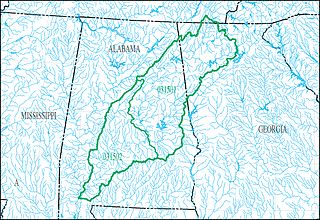
The Alabama-Coosa-Tallapoosa River Basin is a drainage basin (watershed) in the Southeastern United States. The basin is located mainly in eastern Alabama, but also goes includes a small part of Georgia. This area is classified as a sub-region by the USGS hydrological code system.
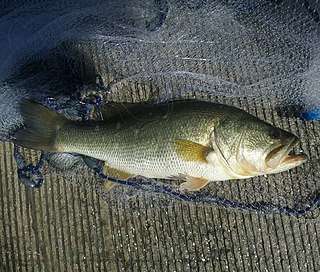
The Florida bass is a species of freshwater ray-finned fish, a black bass belonging to the sunfish family Centrarchidae of order Perciformes. It is found in the southeastern United States.
Lake Athens is a 1,799 acre reservoir located to the east of Athens, Texas in Henderson County.
